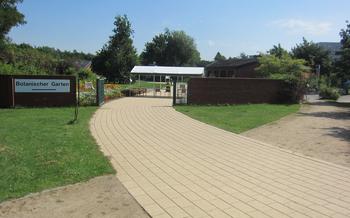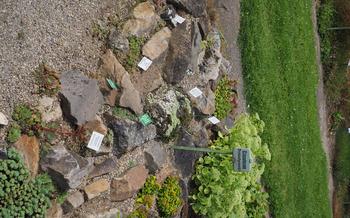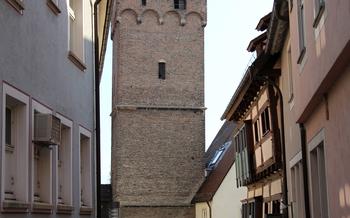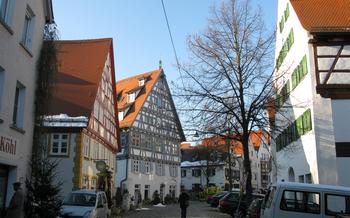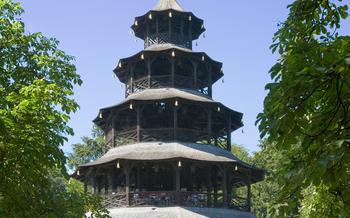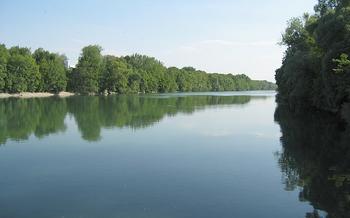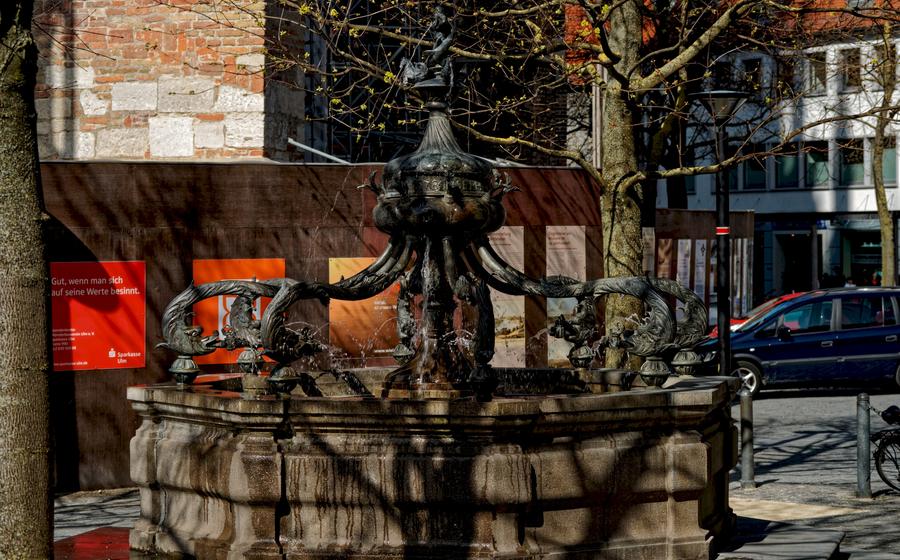
Botanical Gardens of the University of Ulm (Botanischer Garten der Universität Ulm)
- A University's Green Oasis
- Guided Tours
- Thematic Gardens: A Journey Through Plant Diversity
- The Botanical Gardens of the University of Ulm: Plant Collections
- The University of Ulm's Botanical Garden: Educational Programs
- Events and Exhibitions
- Hands-On Activities
- Accessibility
- Photography Opportunities
- Family-Friendly Atmosphere
- Research and Conservation
- Sustainability Practices
- Volunteering Opportunities
- Insider Tip: Unveiling Hidden Gems
A University's Green Oasis
The Botanical Gardens of the University of Ulm is a haven of tranquility nestled within the bustling city of Ulm. Established in 1981, the garden is an integral part of the university's Faculty of Natural Sciences and serves as a valuable resource for teaching, research, and public outreach. Its mission is to promote plant diversity, conservation, and sustainable practices while providing a serene and inspiring environment for students, researchers, and visitors alike.
With over 6,000 plant species from around the world, the garden is a living museum of plant life. It boasts a diverse collection of rare and endangered species, as well as common and well-known plants. The garden's thematic sections, such as the rose garden, the medicinal plant garden, and the butterfly garden, offer visitors a unique perspective on the diversity and beauty of the plant kingdom.
Beyond its educational and scientific significance, the botanical garden is also a place of beauty and tranquility. Its lush greenery, colorful flowers, and tranquil atmosphere make it an ideal spot for relaxation and inspiration. Visitors can wander through the garden's winding paths, admire the vibrant blooms, and find a peaceful corner to sit and reflect amidst nature's beauty.
Guided Tours
The Botanical Gardens of the University of Ulm offer guided tours for visitors who want to delve deeper into the world of plants and their significance. These tours are led by knowledgeable guides who provide insights into the garden's history, plant collections, and research activities.
Benefits of Guided Tours:
Guided tours offer several benefits to visitors:
-
Expertise and Insights: Experienced guides share their knowledge about the plants, their habitats, and their importance in the ecosystem. Visitors can learn about plant identification, plant biology, and the latest research findings.
-
Personalized Experience: Tours can be customized to meet the interests and needs of different groups. Guides can tailor the tour content to focus on specific plant families, medicinal plants, or the garden's conservation efforts.
-
Engaging Storytelling: Guides bring the garden to life with captivating stories about the plants, their discoveries, and their role in human history and culture.
Types of Tours:
The botanical garden offers a variety of guided tours, including:
-
General Tours: These tours provide a comprehensive overview of the garden, its history, and its plant collections.
-
Themed Tours: Thematic tours focus on specific aspects of the garden, such as medicinal plants, roses, or butterflies.
-
Group Tours: Group tours are available for schools, organizations, and other groups. Tours can be customized to meet the specific needs of the group.
Booking and Cost:
To book a guided tour, visitors can contact the botanical garden's administration office or reserve a spot online. The cost of guided tours varies depending on the type of tour and the number of participants.
Conclusion:
Guided tours at the Botanical Gardens of the University of Ulm offer a unique opportunity to learn about the fascinating world of plants and their significance. Led by knowledgeable guides, these tours provide an engaging and personalized experience that enhances the visitor's appreciation for the garden's beauty and biodiversity.
Thematic Gardens: A Journey Through Plant Diversity
Within the Botanical Gardens of the University of Ulm, visitors can embark on a journey through diverse thematic gardens, each offering a unique perspective on the plant kingdom. The rose garden, a fragrant oasis of color, showcases a stunning array of rose varieties, from classic red roses to delicate pastels. Visitors can admire the beauty of these timeless blooms and learn about their history and cultivation.
The medicinal plant garden invites visitors to explore the healing power of plants. Here, they can discover a wide range of herbs and flowers traditionally used for medicinal purposes. Informative signage provides insights into the medicinal properties of each plant, highlighting their traditional and modern applications.
A haven for butterflies and other pollinators, the butterfly garden is a vibrant display of color and life. Visitors can observe the intricate beauty of butterflies as they flutter among nectar-rich flowers, learning about the importance of these delicate creatures in maintaining biodiversity.
These thematic gardens, along with many others, contribute to the overall diversity and interest of the Botanical Gardens of the University of Ulm. They offer visitors an opportunity to explore specific aspects of the plant kingdom, gain valuable knowledge, and appreciate the beauty and complexity of the natural world.
The Botanical Gardens of the University of Ulm: Plant Collections
The Botanical Gardens of the University of Ulm house a vast and diverse array of plant collections, representing a treasure trove of botanical wonders from around the world. These collections serve multiple purposes, contributing to scientific research, conservation efforts, and the education and enjoyment of visitors.
Scientific Research: The botanical garden's plant collections provide a valuable resource for scientific research. Researchers from the university and beyond utilize these collections to study plant taxonomy, genetics, ecology, and other fields. The gardens' controlled environment and diverse plant species allow for in-depth investigations into plant growth, adaptation, and interactions with their surroundings.
Conservation Efforts: The botanical garden plays a crucial role in plant conservation, particularly for rare and endangered species. By cultivating and maintaining these species ex situ, the garden contributes to their survival and genetic diversity. The collections serve as a backup population in case of habitat loss or other threats, ensuring that these species have a chance to thrive even when their natural habitats face challenges.
Educational Value: The plant collections offer an invaluable educational tool for students, researchers, and the general public. Visitors can learn about the diversity of plant life, the importance of plant conservation, and the various roles that plants play in our ecosystem. The gardens provide a living classroom where students can observe and study plants firsthand, fostering a deeper understanding of the natural world.
Aesthetic Appeal: Beyond their scientific and educational value, the botanical garden's plant collections offer a feast for the eyes. The vibrant colors, intricate forms, and delicate fragrances of the plants create a visually stunning display. Visitors can wander through the gardens, admiring the beauty of nature and finding inspiration in the diverse array of plant life.
The plant collections at the Botanical Gardens of the University of Ulm stand as a testament to the power of plants and the importance of their conservation. Whether for scientific research, educational purposes, or simply for the sheer joy of appreciating nature's beauty, these collections offer something for everyone to explore and enjoy.
The University of Ulm's Botanical Garden: Educational Programs
The Botanical Gardens of the University of Ulm offer a comprehensive range of educational programs and workshops for students, researchers, and the general public. These programs aim to promote plant knowledge, encourage sustainable gardening practices, and raise awareness about plant conservation.
Educational Programs for Students: - Plant Identification Workshops: Learn to identify different plant species based on their characteristics and taxonomy. - Plant Propagation Workshops: Gain practical experience in propagating plants through various methods like cuttings, grafting, and seed germination. - Sustainable Gardening Workshops: Explore eco-friendly gardening techniques, including organic pest control, water conservation, and companion planting.
Educational Programs for Researchers: - Plant Taxonomy Workshops: Delve into the classification and naming of plants, including the latest developments in molecular systematics. - Plant Ecology Workshops: Study the interactions between plants and their environment, including topics like plant-pollinator relationships and plant adaptations. - Plant Genetics Workshops: Learn about the genetic diversity of plants and how it relates to conservation and breeding.
Educational Programs for the General Public: - Guided Nature Walks: Explore the botanical garden with a knowledgeable guide and learn about the various plant species, their origins, and their ecological significance. - Children's Programs: Engage kids in interactive activities like planting workshops, nature crafts, and storytelling sessions, fostering their love for plants and nature. - Gardening Workshops: Learn about basic gardening techniques, including soil preparation, plant selection, and pest management.
These educational programs are designed to cater to different interests and levels of knowledge, providing participants with valuable insights into the world of plants and their importance to our planet.
Events and Exhibitions
The Botanical Gardens of the University of Ulm hosts a diverse range of special events, exhibitions, and festivals throughout the year, offering visitors unique and engaging experiences. These events create a festive atmosphere and a sense of community, attracting both locals and tourists alike.
In the springtime, the garden comes alive with the "Spring Awakening Festival", showcasing the vibrant colors and fragrances of the blooming flowers. Visitors can stroll through the gardens, admire the floral displays, and participate in workshops on gardening and plant care.
Summer brings the "Botanical Art Exhibition", featuring stunning artwork inspired by the beauty of plants. Local artists showcase their paintings, sculptures, and photographs, creating a fusion of art and nature that captivates the senses.
As autumn arrives, the garden transforms into a canvas of golden hues during the "Autumn Foliage Festival". Visitors can witness the changing colors of the leaves, take part in guided nature walks, and enjoy seasonal treats and beverages.
During the winter months, the botanical garden hosts the "Winter Wonderland Festival". The gardens are adorned with twinkling lights, festive decorations, and ice sculptures, creating a magical atmosphere. Visitors can sip on warm drinks, listen to live music, and experience the beauty of the winter landscape.
These events and exhibitions not only enhance the visitor experience but also contribute to the garden's mission of education and conservation. By participating in these events, visitors can learn more about plants, appreciate their beauty, and support the garden's ongoing efforts to preserve plant diversity.
To stay informed about upcoming events and exhibitions, visitors can check the botanical garden's website or social media pages. Advance booking is recommended for some events, especially during peak seasons.
Hands-On Activities
The botanical garden offers a range of hands-on activities and interactive learning experiences that allow visitors to engage with the plant world in a deeper and more meaningful way. These activities are designed to foster a sense of wonder and curiosity about plants and their importance in our lives.
One popular activity is the planting workshop, where participants can get their hands dirty and learn how to propagate and care for plants. Guided nature walks are another great way to explore the garden's diverse plant collections and learn about the ecology and history of the site. These walks are led by knowledgeable guides who share their insights and expertise with participants.
For younger visitors, the botanical garden offers a variety of educational programs and activities tailored to their interests and abilities. Children can participate in interactive workshops, nature storytime sessions, and guided tours designed to spark their curiosity and imagination. These programs help children develop a love of nature and an understanding of the importance of plants in our world.
By participating in hands-on activities at the botanical garden, visitors can gain a deeper appreciation for the beauty and diversity of the plant kingdom. These activities provide a unique opportunity to learn about plants, connect with nature, and create lasting memories.
Accessibility
The Botanical Gardens of the University of Ulm are committed to providing an accessible and inclusive environment for visitors of all abilities. Wheelchair-accessible paths and ramps are strategically placed throughout the garden, ensuring that all visitors can comfortably navigate the grounds. Restrooms have also been designed with accessibility in mind, featuring wide doorways, grab bars, and accessible sinks. Additionally, the garden offers special programs and events designed specifically for visitors with disabilities, creating a welcoming and inclusive atmosphere for everyone. Visitors who require assistance or accommodations are encouraged to reach out to the garden staff, who are always ready to provide support and ensure a seamless and enjoyable experience for all.
Photography Opportunities
Photographers of all skill levels will find the Botanical Gardens of the University of Ulm a haven for capturing stunning images. The diverse plant collections, vibrant colors, and picturesque landscapes create a visual feast that is sure to inspire.
For the best results, plan your visit during the golden hours of sunrise or sunset when the light is soft and warm. Experiment with different angles and perspectives to capture the beauty of the plants and flowers from unique viewpoints. Don't forget to look up to capture the intricate patterns of leaves against the sky or the delicate petals of a flower in full bloom.
Macro photography enthusiasts will find endless opportunities to capture the intricate details of flowers, insects, and other small creatures that inhabit the gardens. A telephoto lens can be useful for capturing close-ups of birds or other wildlife that may be present.
Once you have captured your stunning images, share them with the world on social media using the hashtag #BotanischerGartenUlm. Inspire others to visit this beautiful garden and appreciate the wonders of the plant kingdom.
Family-Friendly Atmosphere
The Botanical Gardens of the University of Ulm welcome families with open arms, providing a nurturing and educational environment for children of all ages. Playgrounds, complete with swings, slides, and climbing structures, offer a safe and fun space for kids to let their imaginations run wild. Picnic areas, scattered throughout the garden, invite families to enjoy a leisurely meal surrounded by nature's beauty. Interactive exhibits, designed with children in mind, transform learning into an exciting adventure. Join in on nature storytime sessions, where captivating tales bring the wonders of the plant kingdom to life. Interactive workshops, tailored to young minds, provide hands-on experiences that foster a deep appreciation for the natural world. Plan a family-friendly visit to the Botanical Gardens of the University of Ulm, and create lasting memories that will inspire a lifelong love of plants and the environment.
Research and Conservation
The Botanical Gardens of the University of Ulm are not just a place of beauty and tranquility but also a hub of scientific research and conservation efforts. The garden's diverse plant collections serve as a living laboratory for botanists and researchers from various disciplines. Projects focused on plant taxonomy, genetics, and ecology are conducted within the garden's premises, contributing to our understanding of the plant kingdom and its role in ecosystems. The botanical garden also plays a crucial role in conservation initiatives. It maintains seed banks to preserve rare and endangered plant species and actively participates in reintroduction programs, helping to restore threatened plant populations to their natural habitats. By supporting the botanical garden's research and conservation initiatives, visitors can contribute to the preservation of our planet's biodiversity and ensure that future generations can continue to enjoy the beauty and benefits of the plant world.
Sustainability Practices
The Botanical Gardens of the University of Ulm is committed to sustainable practices and environmental protection. The garden employs water conservation measures, such as rainwater harvesting and drip irrigation systems, to minimize water usage. Organic gardening techniques are used to maintain the garden's plant collections without the use of synthetic pesticides or fertilizers, ensuring the health of the plants and the environment. Additionally, the garden utilizes renewable energy sources, such as solar panels, to reduce its carbon footprint.
Through educational programs and workshops, the Botanical Gardens promotes sustainable gardening practices and raises awareness about environmental issues. Visitors are encouraged to learn about the importance of biodiversity conservation, responsible plant care, and sustainable landscaping. The garden also offers workshops on topics such as composting, rainwater harvesting, and organic gardening, empowering visitors to make a positive impact on the environment in their own gardens and communities.
By embracing sustainable practices, the Botanical Gardens of the University of Ulm sets an example for other botanical institutions and demonstrates its commitment to environmental stewardship. Visitors to the garden can contribute to these efforts by following sustainable practices during their visit, such as using reusable water bottles, recycling waste, and respecting the garden's plants and wildlife. Together, the garden and its visitors can work towards a greener and more sustainable future.
Volunteering Opportunities
The Botanical Gardens of the University of Ulm offer a unique opportunity for visitors to get involved in the world of plants and contribute to the garden's operations through volunteering. Whether you're a student looking for hands-on experience, a retiree with a passion for gardening, or simply someone who wants to make a difference, there's a volunteer role waiting for you.
Tasks for volunteers can range from gardening and plant care to educational outreach and event planning. Join a team of dedicated volunteers who work together to maintain the garden's beauty, educate visitors, and promote plant conservation. By volunteering your time, you'll not only gain valuable practical experience but also make a positive impact on the community and the environment.
To find out more about volunteering opportunities, visit the Botanical Gardens' website or contact the Volunteer Coordinator. They will guide you through the process and help you find a role that matches your interests and skills. Whether you have a few hours to spare each week or can commit to a longer-term project, your contribution will be greatly appreciated. So, if you're looking for a rewarding and fulfilling way to give back to the community, consider volunteering at the Botanical Gardens of the University of Ulm.
Insider Tip: Unveiling Hidden Gems
Venture beyond the main paths and discover the tranquil nooks and serene corners that the Botanical Gardens of the University of Ulm holds. Seek out the secluded Japanese Garden, a haven of tranquility inspired by the principles of Zen Buddhism. Admire the delicate cherry blossoms in spring, the vibrant reds and oranges of autumn foliage, and the peaceful stillness of the water features.
For a unique perspective, climb the observation tower nestled amidst the treetops. Take in the panoramic views of the garden's diverse landscapes, the city of Ulm in the distance, and the majestic Alps on the horizon. Capture breathtaking photographs or simply soak in the tranquility and let your worries melt away.
If you're in search of a culinary treat, head to the charming café nestled within the botanical garden. Indulge in homemade cakes, freshly brewed coffee, or a refreshing glass of lemonade while surrounded by the beauty of nature.
To fully immerse yourself in the beauty and tranquility of the botanical garden, plan your visit during the early morning or late afternoon when the crowds are fewer. Find a secluded spot beneath a shady tree, spread out a blanket, and enjoy a leisurely picnic amidst the vibrant flora.
